The balance lures came to equip domestic winter fishing fishermen from distant Scandinavia and firmly settled in fishing boxes, partially occupying the niche of popular vertical lures for winter fishing. Most often, balancers are used
when fishing for pike , pike perch and perch, catching a striped robber and will be discussed in this material. Specifically, let’s talk about when it is better to catch perch on balancers, what search and catching tactics, as well as techniques and methods of the game to use, we will offer a rating of the best balancers for winter perch for 2020.
The balancer, in contrast to the vertical winter lure, has a central suspension, and the hooks are located at the extreme points of the bait, in addition a tee is attached at the bottom in the center, often decorated with a bead, a droplet of painted epoxy resin, and a large bisserine.
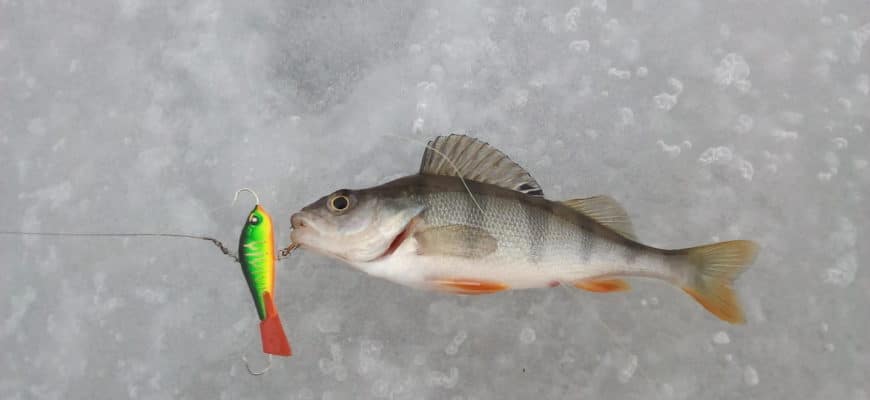
- How it works and why the balancer catches
- Balancer VS vertical rod when fishing for perch
- Catching balancers for winter fishing for perch: the principle of choice, rating of the best for 2020
- How to choose the size
- The best balancer colors for perch
- Working winter balancers for perch: TOP-10 models, time-tested and new
- Balancer fishing tactics when fishing for perch
- Perch parking places
- Drilling holes, moving tactics
- Ways to animate the balancer on perch fishing
- How to improve the catchability of the balance beam – what attracts a sharp-pointed predator
- Hooks: quantity, size
- Whether to decorate the hooks-tees balancers when fishing for perch and what
- Optimal tackle for perch fishing with a balancer
- Nod
- Line or braid?
- How to attach the balancer to the line
- Поделиться ссылкой:
How it works and why the balancer catches
The balancer has a plumage or a stabilizer blade made of plastic, mica, squirrel fluff and other more exotic materials on the back of the bait. It is the shape, size and angle of inclination of the blade that sets the characteristic sweeping play of the balancer. If the bait is balanced correctly, and the angler feeds it skillfully, then depending on the strength of the jerks, the balancer will write out an eight, with one or another size of the swing of the loops to the sides.
Please note that balancers from proven manufacturers (Kuusamo, Nils Master, Rapala, Lucky John and others) have perfect repeatability. And once having mastered catching perch with a certain model, you can be sure that the next “brother”, acquired instead of the lost one, will catch in the same way.
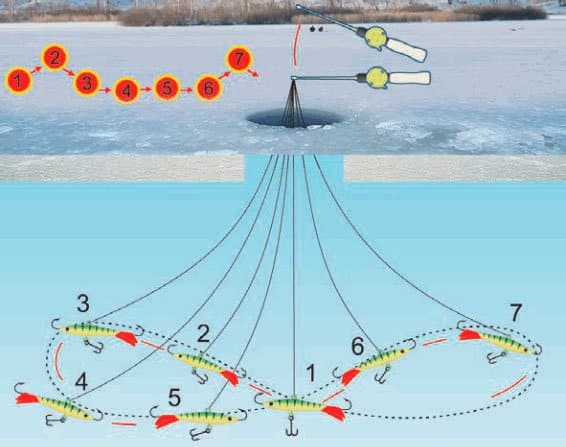

Balancer VS vertical rod when fishing for perch
It can be said unequivocally that it cannot be better, it all depends on the activity of the predator, periods of winter, depth, food supply and other factors. The peculiarity is that the balancer has a more active game than the vertical lure, which is reflected in the advantages and disadvantages of both of these lures. Under certain conditions, it is better
to fish perch with a spoon , in others with a balancer.
Catching balancers for winter fishing for perch: the principle of choice, rating of the best for 2020
The perch balancer must necessarily be equipped with a lower tee, since the striped one often attacks this particular moving part of the bait. At the same time, it is highly desirable that the tee be additionally decorated with a seductive element. In the air, the balancer must necessarily occupy a strictly horizontal position or a slightly raised position of the muzzle, 3-5 degrees relative to the horizontal, no more. You need to be especially careful when choosing lures, not from recognized brands, but so-called nouns.
Advice! Any new balancer should be checked in any accessible place – in the pool, aquarium, bath.
It should be noted that for an active perch, it is worth choosing balancers with a daring and fierce play. In most cases, these lures are equipped with a plastic wing. A passive predator, on the contrary, prefers a lazier game, such is provided by balancers with all kinds of tail feathers. It is this tail that slows down at the end points of the drive, where the bait changes the direction and nature of the game.

How to choose the size
The size of the balancer for catching perch ranges from 35-70 mm, when catching a muzzle up to 90 mm. It makes no sense to use less, unless there is a question of catching live bait. It should be borne in mind that with one linear size, thicker “fatty” will have more weight, and a fairly large spread. For example, with a size of 4 cm, one balancer will have a weight of 6 grams, and the other 11. Thus, we can conclude that more run-down lures are suitable for fishing at depths of up to 3-4 meters, denser knocked down stalwarts at depths of up to 10-12 meters … It is also worth understanding that a lighter one will play smoother and softer than a heavy one, which draws the figure eight sharply, which is not always good. This is an important point and should be taken into account when choosing a bait for your conditions. Another nuance – a short knocked down balancer is more suitable for flow,and here are the sluggish lungs for calm stagnant water. It seems obvious, but not everyone takes it into account.
The best balancer colors for perch
The colors of the balancers are more important for the angler than for the fish. What the winter road believes in, it usually works for him. But you can give some advice. It should be borne in mind that at great depths, as well as early in the morning and in the evening, the fish sees only in the ultraviolet spectrum. There are a whole series of balancers, the so-called fluorescent ones, which are good for fishing at a depth of 5+ meters. But at shallow depths it is worth picking up from the food supply. You can choose a color for gudgeon, roach or bleak trifle. It is good for the balancer to contrast with the bottom coating. On a mule – light, on the sand of the river – dark.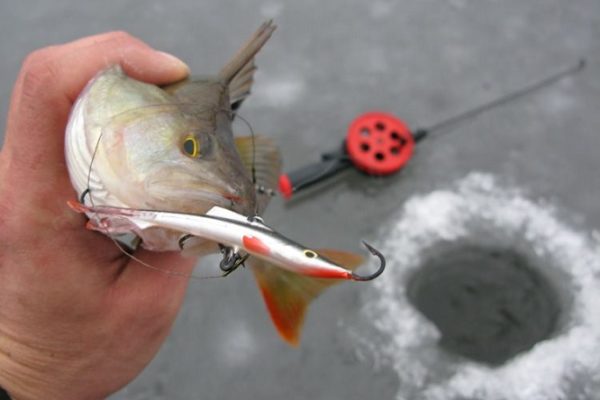
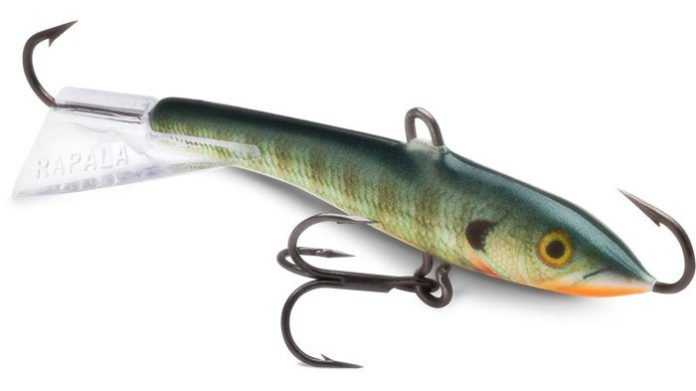
Working winter balancers for perch: TOP-10 models, time-tested and new
Among the popular manufacturers of balancers for catching perch and other predators, it is worth noting such companies as Kuuasamo, Lucky John, Nils Master, Rapala and others. The best and most efficient balancers for perch that work well in winter at different times and in different conditions:
- Lucky John Soft Tail 3 is a catchy perch balancer with a soft play thanks to the presence of a squirrel tail. It is used when the predator is passive and amorphous and prefers slow motion of lures. It does not go far from the center of the hole when playing, it can be used among snags and grass. The only point that should be taken into account is that such a curved body shape is not to everyone’s liking, especially in small bodies of water the striped one prefers running prey, similar to the perch. But where crucian carp, silver bream, roach and other puffy fish are the basis of a sailor’s diet, Soft Tail works out perfectly.
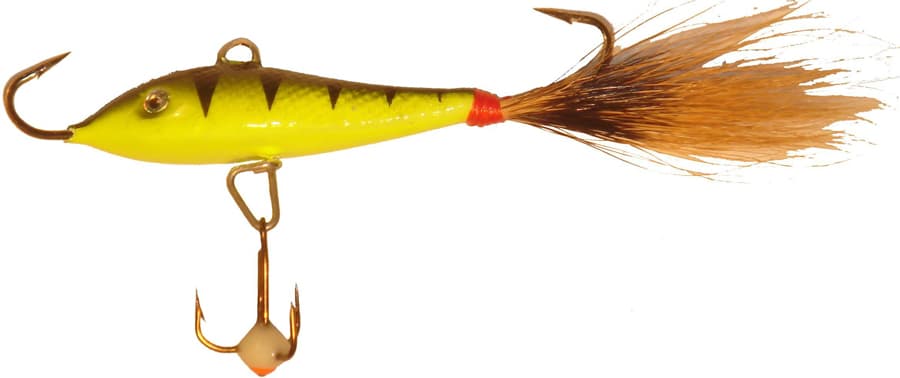
- Lucky John Classic 5 (50 mm) – 13 gram classic BALANCED Lucky John Classic is one of the first to start perch fishing. Suitable for fishing medium and large perch at depths of 6-8 meters, allows fishing in a small course of slow rivers. Writes out a classic eight, suitable for beginners. A good collector on a new hole, has a fierce game. Rigging on monofilament up to 0.18 mm, so as not to knock down the trajectory set by the manufacturer during animation.

- Lucky John Classic 4 (40 mm) – 6 gram sibling of the previous model. With the same form, it has a more measured game. Suitable for fishing at depths of up to 3-4 meters, with no current or with a minimum. Coloring 26 RT (pictured) glows well in the infrared range – what you need for muddy water in low light conditions.

- Nils Master Jigger 2 (10 grams, 70 mm) – a spindle-shaped body and a wide tail stabilizer give the number 2 Jigger a wide play, in which the balance bar at the end points lifts the nose up, and then, smoothly turning, rushes down. It is used at depths up to 6-7 meters. The model is made with a spaced hook, which allows you to catch a passive humpback by knocking on the bottom, raising a cloud of turbidity and destabilizing the state of the perch.
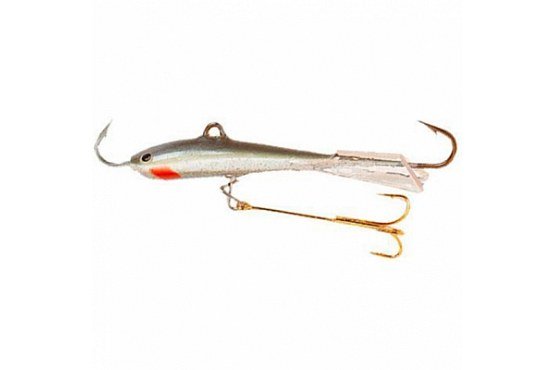
- The Nils Master Jigger 1.5 (8 grams, 50 mm) is again a smaller brother, more versatile for fishing at depths of 2-4 meters. Nimble, with a varied game of stretching of different strength and amplitude. Jiggers are available in a large assortment (see photo). But in our opinion, it is these two models that are most in demand. Number 1 can be used if the depths are very small 1-2 meters, more powerful 3 and 4, or for trophy perch from 800 grams, or for zander and pike.
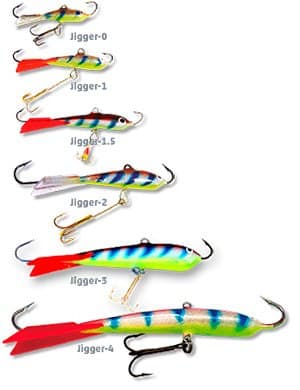
- Rapala Jigging Rap (perch modifications 30, 50, 70 mm 6,9,18 grams)… If Rapala is considered one of the best balancers in the production of balancers, then Jigging Rap is one of the most famous and popular models in their range. This model is in the box for novice winter roads and professionals, it is universal, catchy and multifaceted. A wide range of colors, both classic natural colors, and acid and fluo, suitable for low light. The game is a classic eight, medium aggressive. You can set the animation, both of the search type for an active predator, and for spot fishing of promising sites of passive perch. Creep rod for various melters for catching grass and medium perch in oxbows, floodplains, coastal zones up to 1-2 meters. Five is a universal model for catching perch of different crops. It can be successfully used at depths of up to 3-5 meters. The seventh model for a large muzzle, pike, pike perch.
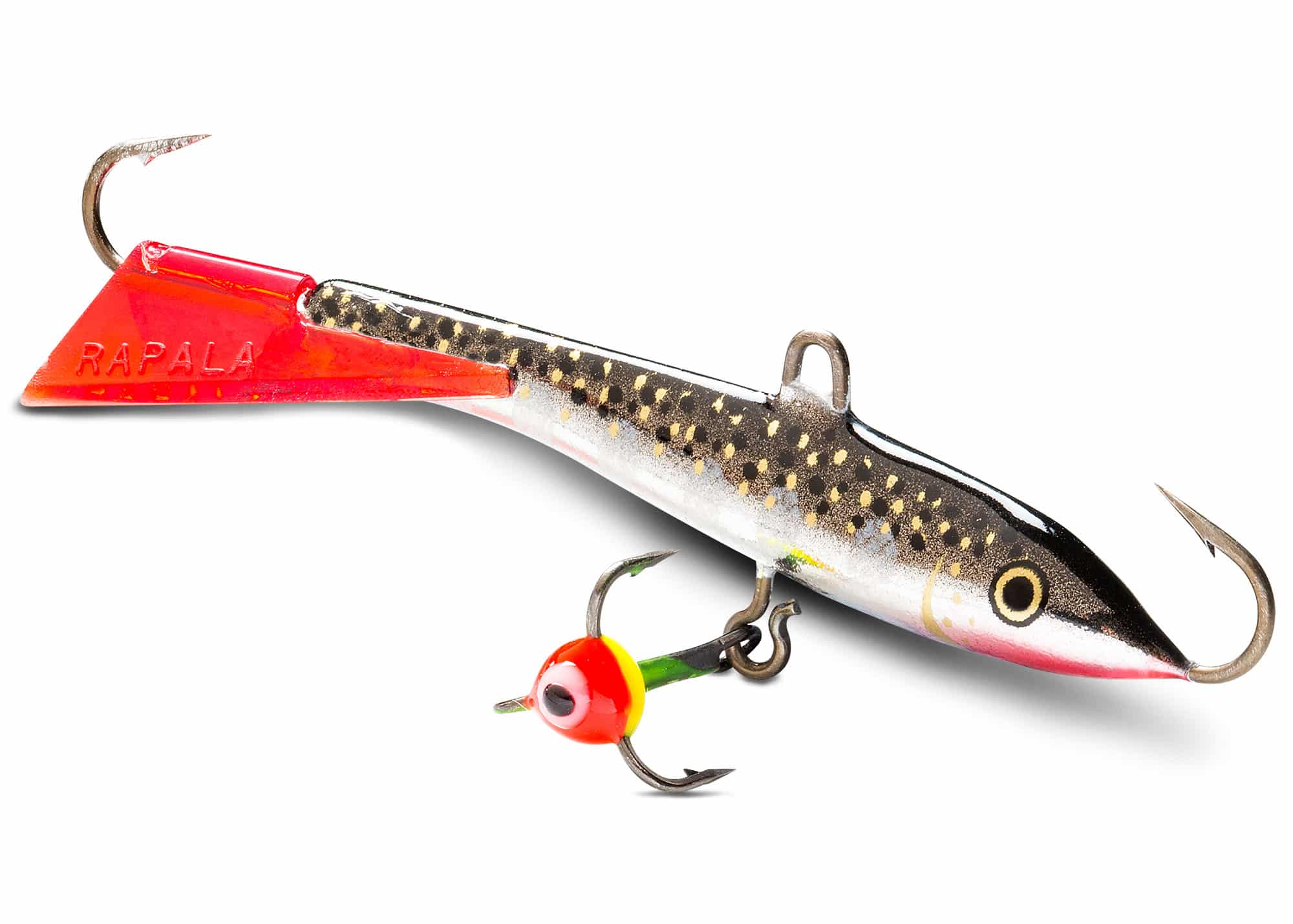
- Lucky John Baltic 3,4,5 is a compact model for fishing deep places with medium and strong currents. It is in demand on large bodies of water and rivers.
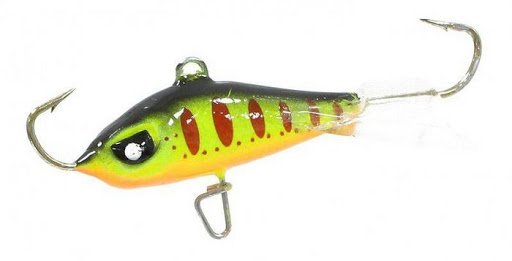
- Kuusamo Tasapaino X-PRO 50, 60, 75 mm 6, 8, 13 grams . Finnish balancers are good at catching both active and passive sailors. Pricey but worth it.
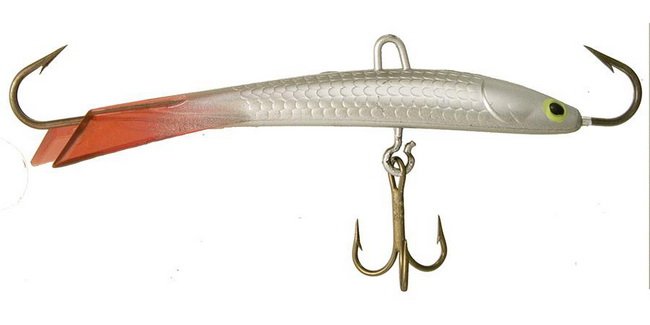
- Scorana Ice Fox, 55 – 10 gram running balancer with ideal body shape for laying glides of maximum latitude. The game is very sweeping on climbs of medium strength, which is to the tastes of an active sailor, and a small eight with small tremors is the most sleepy one.
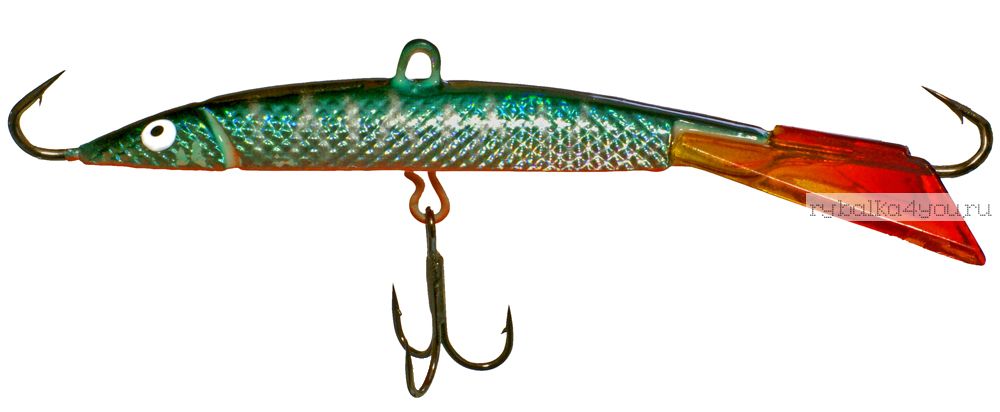
- Scorana Ice Crystal Mark 4, 5 cm, 8 and 12 grams respectively is another quality balance from the Americans. Perfect workmanship – from eyes to holography and scales. It is worth paying attention to the perches fishing on the current. Quite weighty for its size and quickly reaches the bottom.
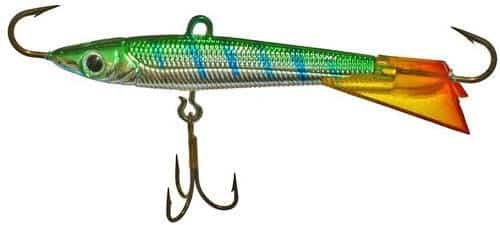
Best perch balancers: https://youtu.be/93YdrT5Zlr8
Balancer fishing tactics when fishing for perch
Balancer is a lure with an active and wide play and is used on active perch at the beginning of freeze-up and on the last ice, when the perch is actively moving and feeding. In the wilderness, it is more promising to hunt for a striped robber with the help of
lures and
mormyshless jigs.… But what if you still want to fish on the balancers from the bottom through the wilderness? It is possible to improve the balancer under the conditions of deafness, when the perch is passive and stands in a semi-braked state at the very bottom. To do this, disconnect the lower tee and, using a flexible wire, move it 5-7 cm from the body of the balancer. In this case, on classic jerks, when the balancer walks in arcs from left to right, it will cling to the bottom with this tee, picking up a cloud of turbidity in one area concentrated under the hole. This dregs attracts striped and he, not understanding the conditions of poor visibility, hits the bait. Such a bait can be used to catch a large and careful humpback, which rarely takes on an ordinary balancer with a wide and active game and even less often in the water column.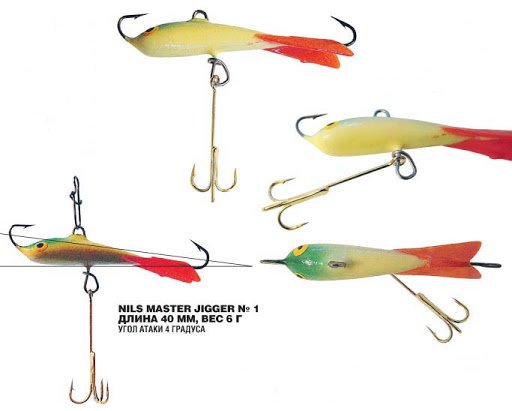
Perch parking places
Depending on the period of winter, the perch moves along the water area in the horizontal and vertical directions. So
early in the hard water seasonit is worth paying attention to the coastal zone – thickets, fallen trees, flooded bushes. Also in the favorite at the moment is the coastal dump, pits on the river plateau, the places where rivers flow into rivers and exits to lakes and oxbows. At this time, the perch is quite actively moving in the hopes of filling up fat for the winter. Fishing at this time is active, with a lot of holes. Aggressive type of animation is used with the use of small and medium balance beams 3-7 cm. Gradually, as the ice thickens and the oxygen content decreases, sailors, especially medium and large ones, slide to great depths. It is worth paying attention to the channel edges, pits and areas near them, any blockages of the snag.
In the wildernessthe predator stands at the bottom and eats little. Slow types of animation are used with not daringly playing balancers, as well as with a spaced tee. In the spring, in the last days of freeze-up, the activity of the sailor increases again and he actively moves through the reservoir and in the water column, following the fry and to the sources of oxygen. They actively fish on small and medium-sized balance beams, both from the bottom and in the water column. Not staying long in one place. For more information on how the perch moves during the winter and the peculiarities of catching it, read the
detailed material .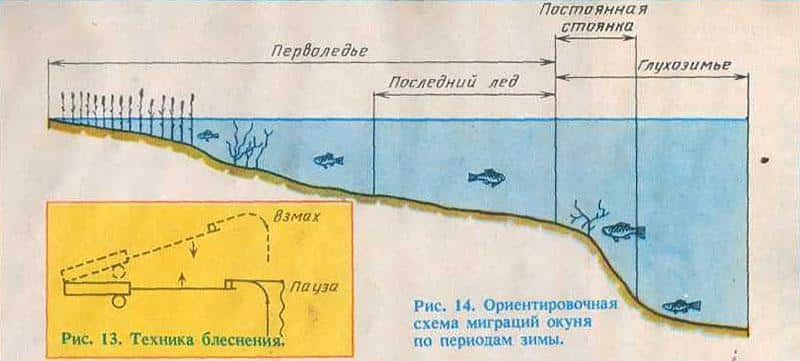
Drilling holes, moving tactics
On the first ice, it makes sense to drill holes along the coastline, examining the coastal zone and dumps in depth. Gradually moving on to the tactics of chess-like drilling of holes along the ditch in depth, figuring out exactly where the striped and nosed one prefers to stand at the given moment of winter.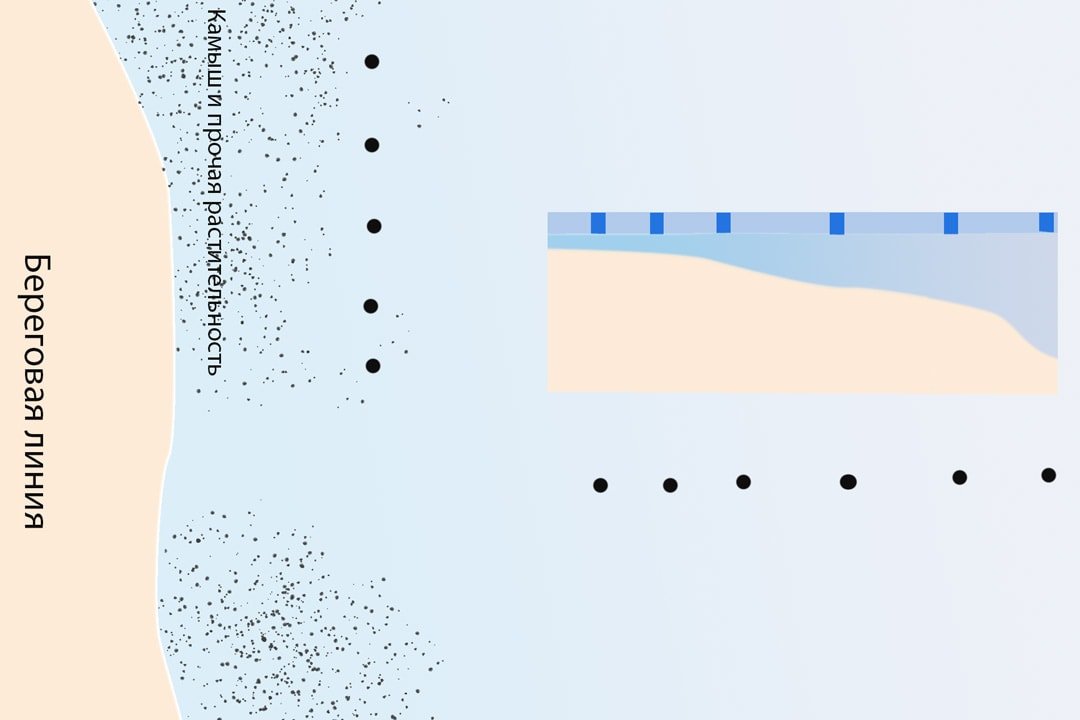
where the perch goes andon spoons .
Ways to animate the balancer on perch fishing
The main type of animation of the balance bar is
jerks of this or that strength and amplitude (classic swing-pause) . The secret to a successful balancer game lies in well-defined swings and pauses that correspond to these jerks. Let’s remind the scheme of the game of any correctly adjusted balancer:
Knock on the bottomoften helps out when the bite dies down. 5-10 knocks on the bottom in short jerks and then play with more sweeping pulls. Every 8-12 iterations with one type of animation should be replaced by the next type of game with longer pauses, for example, or more amplitude jerks. Change of game of balancer – provocateur for okushat.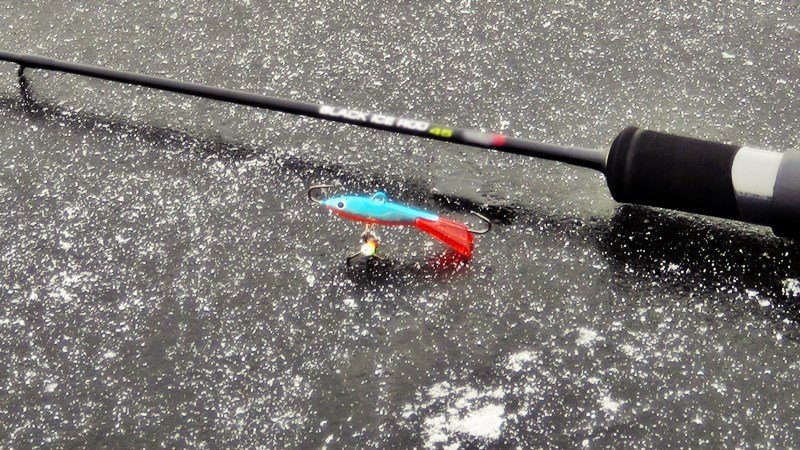
Teasing consists in continuous and smooth swings, during which the balasnir leaves with wide glides to the sides of the hole. At the same time, pauses when the balancer returned vertically under the hole are not made. After 5-10 such swings, a pause is made. Irritated perches are often grabbed on pause. This game is used on new holes to lure striped holes from a long distance.
Finnish life hack, which also works for our predator. On the new hole, we stir up the perch with large 70 mm balance weights, collect it for lunch at our table and at the first bite we change the active balancer to a more relaxed vertical spoon. Since it has been proven by video filming and practical results that you need to collect a curious striped one with the most sharp and actively playing baits (the so-called swinging of the hole), but you need to catch and even more to top up less active brothers with smoother playing with vertical spinners, then bottom and then
rewoundless ones .
https://youtu.be/2Ji9EvXWkQk Fishing for perch and pike on a balancer in 2020: https://youtu.be/tX_iofzyPpM
How to improve the catchability of the balance beam – what attracts a sharp-pointed predator
Both a stock balancer from well-known manufacturers and a home-made one can be modified if fishing for winter perch is planned. There are several points.
Hooks: quantity, size
It is believed that you can increase the number of the tee when fishing for perch and make it more easily soiled. Since the striped robber often attacks this particular part of the bait, and it is good if it is in the predator’s field of vision for a longer time.
Whether to decorate the hooks-tees balancers when fishing for perch and what
Yes! Mandatory, if not provided for by the design of the stock bait from the factory. It is when fishing for perch that a decorated tee is of great importance – with cambric, epoxy, mica, bead, beads. Often the perch hits exactly this part of the bait – the so-called additional point of attack. This is an additional irritant for the striped nosed, in summer and winter. Such decorating droplets on a tee often help when fishing for passive perch, and can also provoke a minke whale striking a balancer, but with a closed mouth.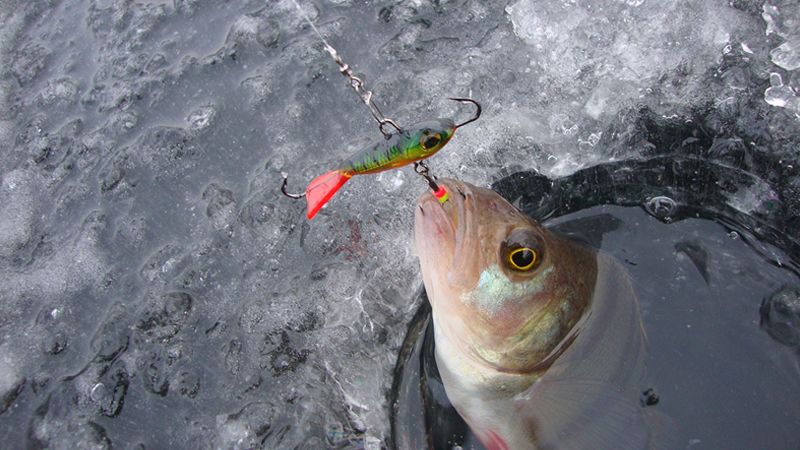
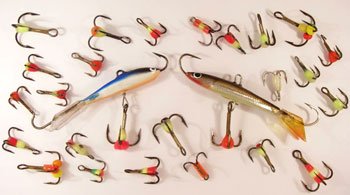
Many manufacturers deliberately make balancers immediately with droplets on hooks, but even if you have a model without such decoration, we recommend using one of the suggested ones to increase the number of bites.
As an enticing element, you can independently impose a fly, drop a drop of painted epoxy resin, put a cambric, hang beads or beads. An interesting video about winter fishing for large perch with a balancer – search places on a large reservoir, drilling tactics, game method: https://youtu.be/35Zt5gyZRIE
Optimal tackle for perch fishing with a balancer
We will start from the thesis that the balance bar is a bait for catching active fish, which implies constant movement across the reservoir, and therefore it is advisable to catch while standing. Therefore, a fishing rod is selected with a long sonorous whip, for example, made of carbon fiber. The length is up to 60-90 cm. This rod can be used to fish while standing, dropping the tip almost to the hole, which allows you to make the most refined jerks, eliminating the parasitic influence of the wind and the physiology of the angler. In our opinion, you should have at least two tackle for winter perch fishing on a balancer. One is powerful for fishing with heavy lures of 50-80 mm in size, and the second is lighter for lures of 30-40 mm. It is worth picking up the fishing rods so that the whip does not fall through under load, but at the same time it is loaded enough so that it is not like a staff, but does not set an excessively tough game to the balancer, i.e.I did not act out it on stretches of the required strength and amplitude. That is, the rod is selected (test, stiffness) based on the size of the balancer you plan to fish for. The coil is selected in a small size, often inertial. The main quality is reliability, there are no special requirements for the move, so the reel when fishing on balancers is needed only in order to store a supply of fishing line, and also choose or add the necessary meters when moving to new depths. In the process of fishing on the hole, the reel is not used.to store a stock of line, and also to select or add the necessary meters when moving to new depths. The reel is not used during fishing on the hole.to store a stock of line, and also to select or add the necessary meters when moving to new depths. In the process of fishing on the hole, the reel is not used.
Nod
The expediency of using a nod when fishing for perch on a balancer is a controversial point. It largely depends not only on the personal preferences of the angler, but also on the manner of his game, depth of fishing, wind, etc. Often there is no need for a nod, the rod itself transfers all the movements of the balance bar to the hand, as well as the bites of the predator. But sometimes the sensitivity of the blank is not enough. For example:
- fishing for small perch;
- the use of thin monofilament lines;
- strong wind;
- fishing at great depths.
Under such conditions, it is worth using a nod from a clock spring, a piece of nipple, lavsan. It should be borne in mind that the nod has the function of visualizing the bite; it does not participate in the animation of the balance bar. The nod should not be harsh and should not interfere with the play of the bait!
Line or braid?
Monofilament special heat-resistant fishing line. Diameter 0.12-0.24, the diameter is matched to the balance to the tackle. The thicker the line, the larger the bait. If you take a thinner line, it is fraught with breakages, a thicker one already affects the game of the bait, of course, for the worse. There are those who like to use braided cords for winter fishing. This approach has its advantages. The main thing is excellent sensitivity at all stages of work with the balancer. But there are also disadvantages – the cord is afraid of low temperatures, freezing and the aggressive effects of ice, and also alarms a large okushka.
Be sure to treat the braid with a special silicone grease!
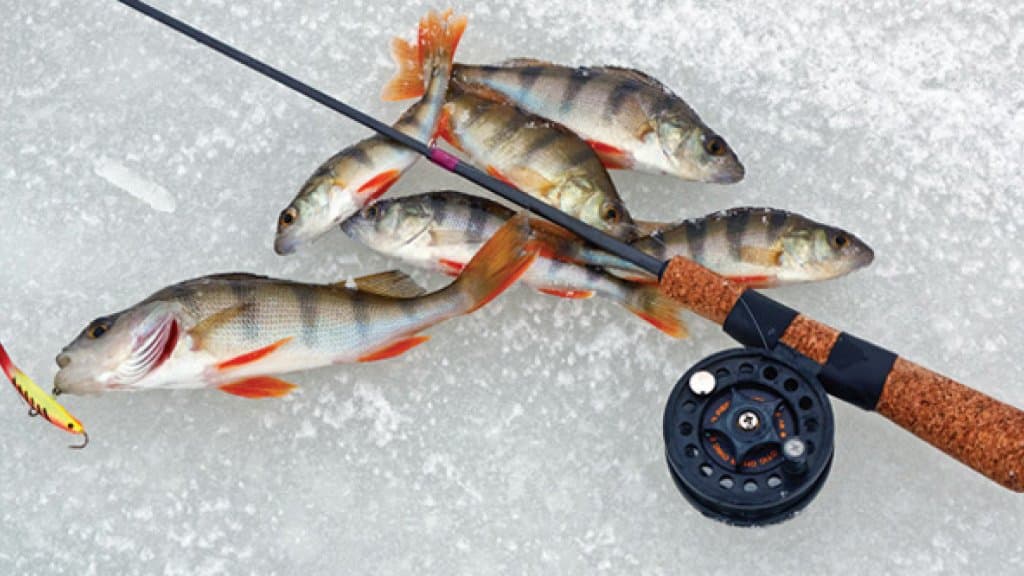
How to attach the balancer to the line
It is recognized that for perch fishing, it is best to attach the balance bar to the line loosely so that it does not lose the freedom to play. When attaching, clinch and rapala knots are directly suitable: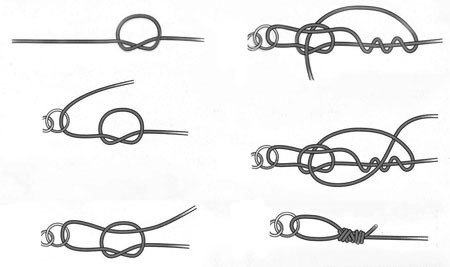
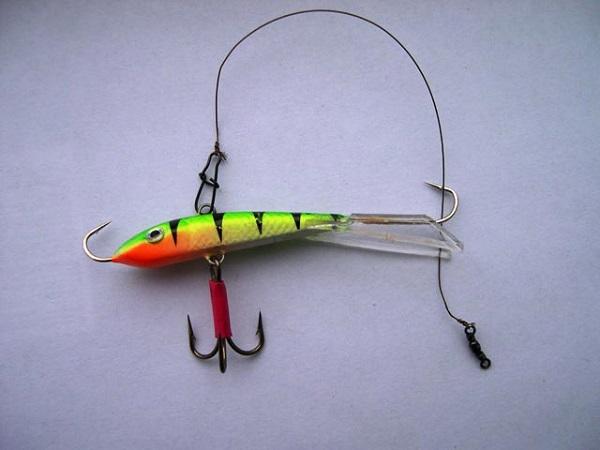
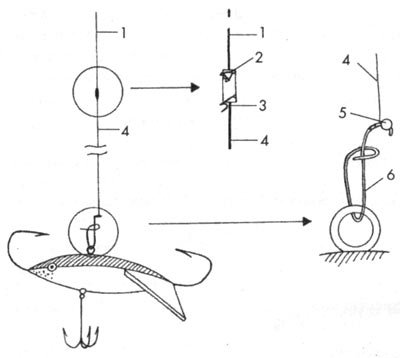
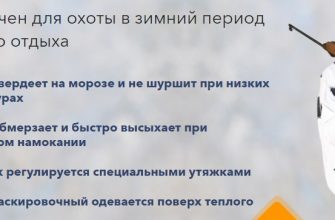
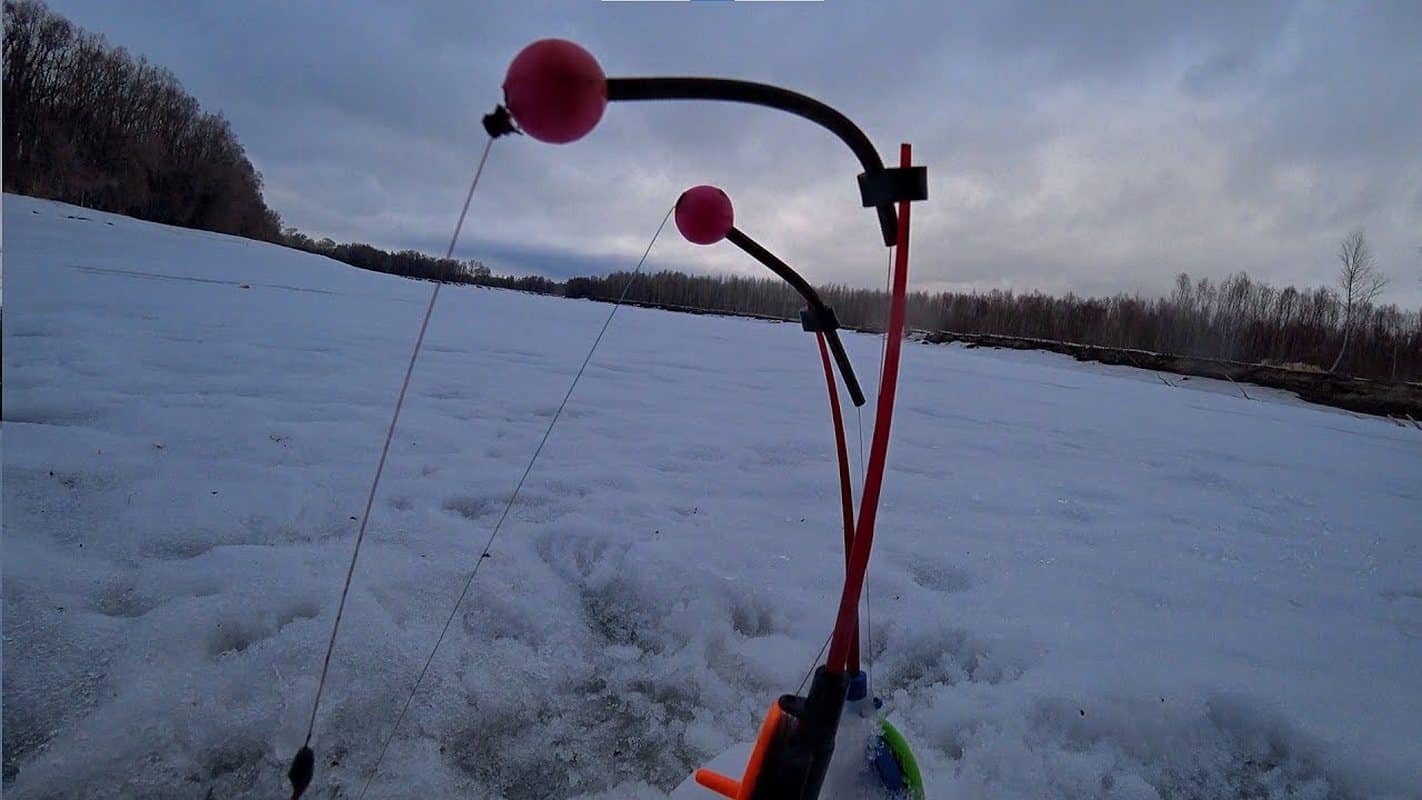

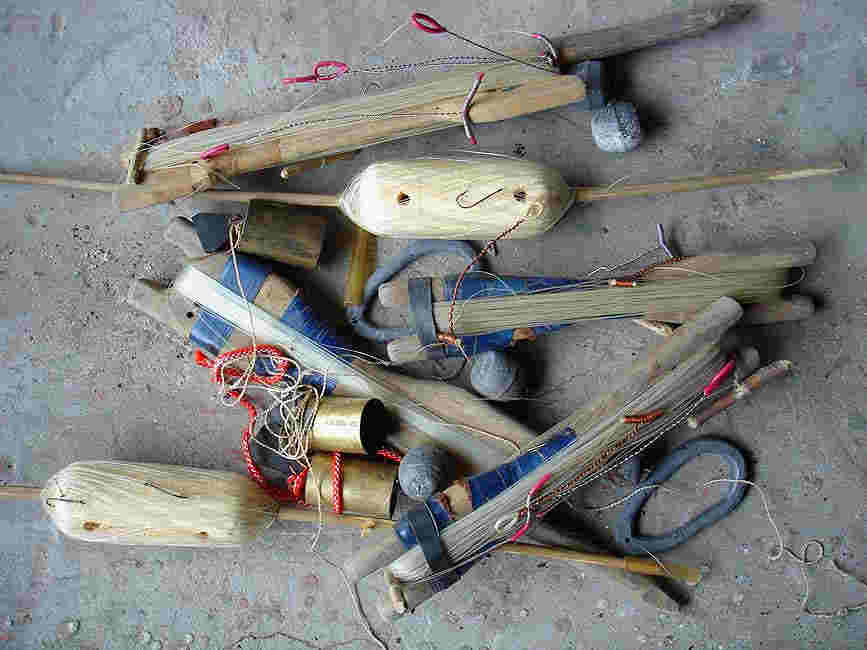
Недавно рыбачили в Иртыше ,с балансиром. Оказался очень удобный способ , за раз можно поймать несколько рыб, это очень радует ,особенно зимой . Когда покупаете балансир , следует проверить его в бассейне или в ванне.
Недавно рыбачили в Иртыше ,с балансиром. Оказался очень удобный способ , за раз можно поймать несколько рыб, это очень радует ,особенно зимой . Когда покупаете балансир , следует проверить его в бассейне или в ванне. Удобно использовать ,
при ловле окуня украсили тройник кембриком, при ловле этот очень важно .Также, когда мы выбирали балансир ,было несколько видов балансиров . Это для ловли мелких рыб ,средних и крупных. Если вы новичок можете приобрести несколько балансиров разного окраса ,например натурального ,синего окрасов. Ловить на балансир отличный способ.
Недавно рыбачили в Иртыше ,с балансиром. Оказался очень удобный способ , за раз можно поймать несколько рыб, это очень радует ,особенно зимой . Когда покупаете балансир , следует проверить его в бассейне или в ванне. Удобно использовать , при ловле окуня украсили тройник кембриком, при ловле этот очень важно .Также, когда мы выбирали балансир ,было несколько видов балансиров . Это для ловли мелких рыб ,средних и крупных. Если вы новичок можете приобрести несколько балансиров разного окраса ,например натурального ,синего окрасов. Ловить на балансир отличный способ.
Источник: https://tytkleva.net/zimnyaya-rybalka/lovlya-okunya-na-balansir.htm#comment-607
Недавно рыбачил у себя на озере , решил приобрести “балансир”. Давно советовали друзья, и решился взять. В первые 10 минут с одной лески поймал 2 рыбины. В рыболовном магазине очень широкий выбор “балансиров”. Взял себе всех по немногу. Понравился способ, спасибо за статью !